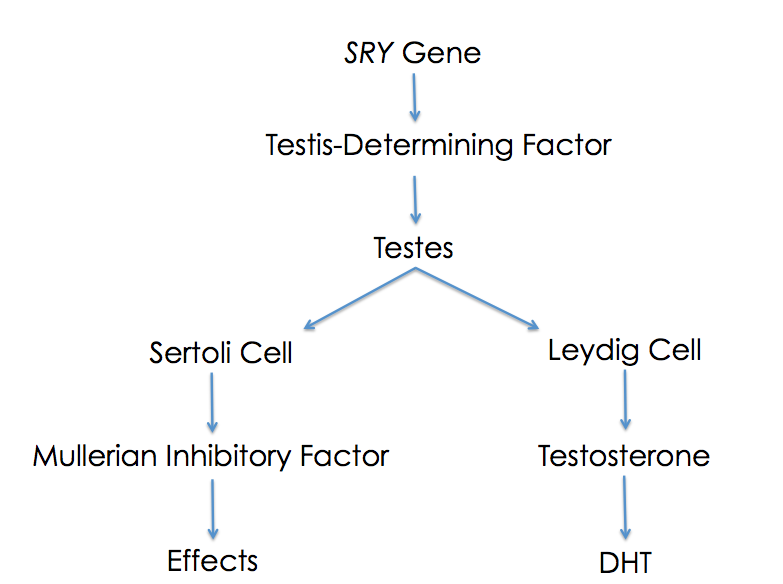WBR0336
Jump to navigation
Jump to search
| Author | [[PageAuthor::Yazan Daaboul, M.D. (Reviewed by Alison Leibowitz)]] |
|---|---|
| Exam Type | ExamType::USMLE Step 1 |
| Main Category | MainCategory::Physiology |
| Sub Category | SubCategory::Genitourinary |
| Prompt | [[Prompt::The image below illustrates the normal development of male genitalia, initiated following the expression of testis-determining factor by the SRY gene on the Y chromosome. In human males, there is a clear relationship between levels of testosterone and Mullerian inhibitory factor (MIF) or anti-Mullerian hormone (AMH). Which of the following statements best describes the relationship between testosterone and AMH? |
| Answer A | AnswerA::Serum testosterone inhibits AMH in the puberty period but not in the neonatal period. |
| Answer A Explanation | AnswerAExp::Serum testosterone does not have a major role in the inhibition of anti-Mullerian hormone. |
| Answer B | AnswerB::Serum testosterone inhibits AMH in the puberty period and in the neonatal period. |
| Answer B Explanation | AnswerBExp::Serum testosterone does not have a major role in the inhibition of AMH. |
| Answer C | AnswerC::Intratesticular testosterone inhibits AMH in the puberty period but not in the neonatal period. |
| Answer C Explanation | AnswerCExp::In the neonatal period, Sertoli cells lack any androgen receptors. Thus, AMH is not inhibited by testosterone in the neonatal period. However, intratesticular testosterone inhibits AMH in the pubertal period. |
| Answer D | AnswerD::Intratesticular testosterone inhibits AMH in the pubertal period and the neonatal period. |
| Answer D Explanation | AnswerDExp::Intratesticular testosterone does not inhibit AMH in the neonatal period. |
| Answer E | AnswerE::Both serum and intratesticular testosterone inhibit AMH in the puberty period and in the neonatal period. |
| Answer E Explanation | AnswerEExp::Serum testosterone does not have a major role in the inhibition of anti-mullerian hormone. AMH is not inhibited by testosterone in the neonatal period. |
| Right Answer | RightAnswer::C |
| Explanation | [[Explanation::Anti-mullerian hormoner (AMH) or mullerian inhibitory factor (MIF) is secreted by the immature Sertoli cells. In the neonatal period, AMH levels are elevated and are not inhibited by the action of testosterone, as Sertoli cells lack any receptors for androgens in the neonatal period. Conversely, when males reach puberty, AMH levels are significantly decreased, due to the pubertal development of the Sertoli cells. Remarkably, the decrease in AMH levels are seen before the rise of serum testosterone levels is seen in male subjects at puberty. This observation led to the discovery that intratesticular testosterone is the real inhibitor of AMH at puberty. This physiological process is absent in patients with androgen-insensitivity, whereby AMH levels remain elevated by the function of FSH without any inhibitory effects of androgens. Educational Objective: Intratesticular testosterone inhibits AMH (or MIF) in the pubertal period, but not in the neonatal period. Treatment with FSH increases AMH, whereas treatment with exogenous testosterone decreases AMH due to the inhibition of endogenous intratesticular testosterone. |
| Approved | Approved::Yes |
| Keyword | WBRKeyword::Testosterone, WBRKeyword::Anti-mullerian hormone, WBRKeyword::Sertoli, WBRKeyword::cells, WBRKeyword::Androgens, WBRKeyword::SRY, WBRKeyword::genes, WBRKeyword::Male embryology, WBRKeyword::Male development, WBRKeyword::Androgen insensitivity |
| Linked Question | Linked:: |
| Order in Linked Questions | LinkedOrder:: |
